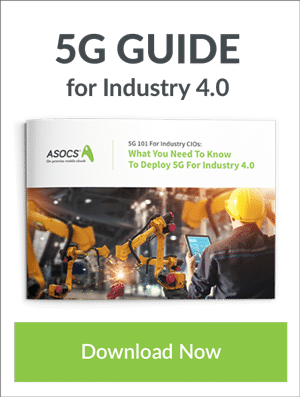How Industry 4.0 benefiting from 5G private networks for health and safety
By Alon Arnon, Country Manager and VP Strategic Accounts

ASOCS is disrupting the industrial network connectivity market with an open and virtualized software solution that delivers 5G private mobile network solutions in a single software stack.
Introduction
When we talk about Industry 4.0 and automation there are 3 main use cases where 5G enables real time AI applications:
- Applied Mobility
- Applied Imaging
- Applied Big Data
The speed, configurability, and stability of 5G over regular networks lends each of these applications to function at an optimal level to enable AI decisions in real time. For example, 5G private networks do not require data to be sent to an ISP and back leading to latency or acceleration to overcome latency, or, with 5G you can configure the performance of upload and download speeds.
It is with Applied Imaging we are seeing more implementations particularly in the field of smart health and safety applications.
Why 5G for Applied Imaging
Before diving into how 5G private networks are being rolled out for health and safety, it worth looking at why the unique properties of 5G are so critical. We are looking at connecting cameras to a network for the purposes of identifying potential risks and taking automated action in real time. The camera is not equipped with any other function than to transmit video images.
The analysis of the images needs to be processed externally, evaluated, and using AI execute actions based on the analysis. This required speed, reliability, and stability.
5G offers stable reliability. As a closed system the network performance cannot suffer from interference from devices on similar bandwidths as with a private network you own the bandwidth you use. As a closed network no-one has access to the network making it more secure. 5G also offers mobility – you need to move or add a camera, you do not need to run new cables or connections regardless of which zone you add or move a camera to.
A main advantage of 5G is configurability. Imagine your home internet connection; you may seem to have a fast connection, but the speed your connection is measured at is in ideal conditions on download and typically the upload speed is only 10% of the download. For example, a 200 Mbps connection means up to 200 Mbps download but typically just 20 Mbps upload. The camera does not need to download anything, it needs to upload images. 5G enables configurability of the ratio between download and upload speeds per device. With 5G managing your network, devices and capacity can be as simple as managing any of your other IT systems.
Use Cases for Applied Imaging
There are 4 main uses cases ASOCS has seen for Applied Imaging already: Employee Safety, Manual Errors, Hazard Detection, and more recently, COVID-19 Control.
The first example is the simplest: Employee Safety and automating detection of potential hazards plus alerts. Cameras monitoring the facility feed data to an AI application that looks to see if employees are wearing the correct safety equipment such as helmets, safety glasses, masks, gloves based on understanding their location in the plant and the requirements of that area. Having detected any anomaly alerts are sent real time to ensure the employee takes corrective measures. In addition, the system can also alert on proximity to danger, for example an arm that gets too close to a dangerous piece of machinery and even control or halt the machine before an accident can occur.
The second use case – Manual Errors, also looks to alleviate human error from the plant. Examples could be machinery not turned off correctly or a door not closed completely. Again, here the cameras’ data is processed, alerts and even automated corrective or preventative measures can be taken all in real time.
When it comes to hazard detection this should not be confused with sensors. Here images are analyzed for clues to leakages, flooding or even potential fires. The cameras can cover a wide range of view and AI can interpret signals for potential hazards.
One of the most recent use cases has grown from the COVID-19 pandemic. Here cameras are monitoring both the wearing of mask in areas with a congregation of people, also warning people when they are about to encounter another person and even monitoring body temperatures of staff.
The key to the growth in applied imaging is that the same cameras can be used for all 4 uses cases simultaneously. There is no need for specialized equipment or changing hardware – the heavy lifting is done by AI. If you need to add another use case, simply add another AI application on the server side.
Global Use Case Access
As 5G is a software, use cases are shared across an open community of developers. As new uses cases are implemented around the world, they become available to the community. For example, new uses of Applied Imaging developed in a factory in Taiwan can be taken from a “marketplace” and applied to a similar need in a factory in Germany. In fact, this has already happened at ASOCS. The time and cost of developing new uses becomes negligible, meaning safety use cases are implemented faster, potentially saving lives or serious injury sooner.




